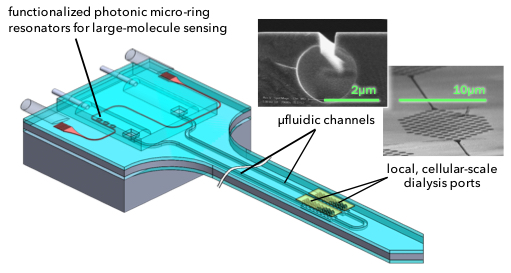

|
| Neuromolecular Sensing | |||
| Research Lab Tour Publications People Gallery Courses Opportunities Links Contact Home |
New approaches from nanoscience are enabling us to transform chemical sensing in the brain
Why is this important? Basically...
Ultimate goal...
What is the current state of art? We have the ability to detect acetylcholine, choline, lactate and dopamine at physiologically relevant concentrations. We have demonstrated and refined the ability to distinguish chemicals of interest from other molecules presnt in the sensing enviornment. We are optimizing wafer scale production and packaging to enable probe dissemination to our neuroscience collaborators. What are we working on right now? Small Molecule Sensing: Our focus is on making the leap from electrochemical sensors validated to detect targets of interest with the temporal and concentration limits of detection of our neuroscience collaborators, to actual deployment of the probes to directly address research questions of fundamental interest to the neuroscience community. Areas of research/development include:
Collaboration with the Shepard lab (https://www.bioee.ee.columbia.edu/research/index.html, Columbia) is enabling customized multi-channel transimpedence amplifiers for this effort. Our goal is to extend the dynamic range from today's capabilities, in which only the most abundant molecular targets can be detected, to one of far greater biological relevance for a diversity of molecular targets. 
Large Molecule Sensing: We are developing a probe to to enable measurement of multiple proteins and peptides with rapid time response (minutes) in deep brain structures of living animals. This platform combines microfluidic channels with dialysis membranes at the tip of the probe to sample the neural environment at the cellular scale. Micro-ring resonator based biosensors detect peptide concentrations in the dialysate. The photonic biosensors are fabricated on the probe surface. Antibodies are covalently attached to the surface of the biosensor, and the sensor detects the binding of a target protein to the antibodies. Experiments can employ sandwich assays (similar to ELISA assays), or can directly detect the peptide in a label- free manner. These probes will provide minute-by-minute protein and peptide concentrations in awake animals, allowing observation of e.g. paracrine signaling between neurons or response to deep brain stimulation. Personnel |
||
| | local users |
|||